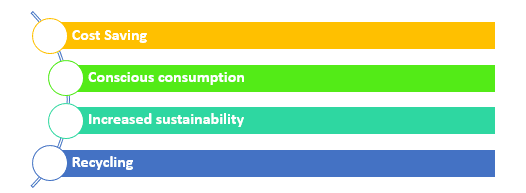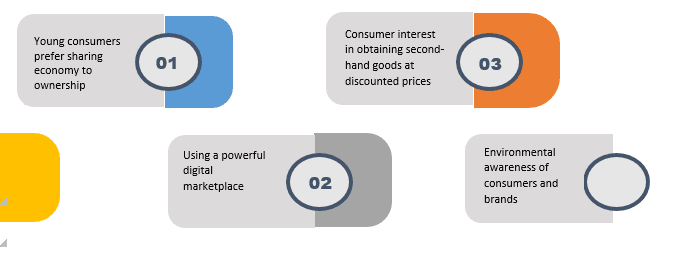Rise of Recommerce: Unlocking Opportunities in the Second-Hand Economy
Overview
Recommerce refers to the purchase and selling of second-hand or used items. This is based on the concepts of “reverse commerce” and “repeat commerce,” in which organisations and people can profit from used products rather than letting them wind up in a landfill. It successfully satisfies the “Reduce-Reuse-Recycle”
Over the past few decades, e-commerce has grown exponentially and has truly changed the nature of business. Millions of people shop online every day, and a significant percentage of those do so more than once a week. This has created lucrative business opportunities that did not exist before the internet. Business is no longer limited to nearby customers.
The recommerce sector is growing significantly as a result of easy-to-use commerce platforms that inspire confidence in transactions. The epidemic is thought to have fuelled the growth of the second-hand clothing sector, which is predicted to increase by 127% by 2026 and reach global sales of $200 billion. Recommerce has evolved from a light-hearted hobby to a significant industry.
How Does Recommerce Work-
Recommerce refers to the large-scale recycling of used goods that are still functional while offering a reasonably priced alternative to purchasing something new. At the micro level, it becomes more challenging and particular to ecommerce.
The practise of buying or selling used goods is no longer limited to the extremely frugal. Reselling generates high-value social currency, higher profit margins, and fresh development opportunities, as brands and retailers are learning. Retailers can capitalise on growing consumer demand for recommerce while establishing their brands by encouraging more environmentally friendly business practises.
Evolution of “Recommerce”
In February 2005, George F. Colony coined the phrase “Recommerce,” noting that “there are many shelf-life difficulties out there. A few releases back are people. older computers. Therefore, calling it “Recommerce,” and it’s a move that needs to be made. ReCommerce has taken the place of “ecommerce.” Initiating the repurchase programme in the early 2000s was a common move among large corporations, and it proved to be a key element in assuring a performance upward slope.
Currently, the approach is modern digital solutions and resale on a mass scale. As per “Cushman & Wakefield” report the target group for this type of shopping is the younger generation of consumers.
Here are some of the recent strategies implemented by companies to develop their commercial business:
- Trove: The brand provides its services to the leading brands such as Levi’s, Eileen Fisher and REI. The company also partnered with a well-known Patagonia company to co-open a digital store called Worn Wear, where you can return used Patagonia clothing and get your money back. Of course, you can also buy used clothes from other users.
- H&M – The company has created a dedicated website for selling COS branded second-hand goods
- IKEA– IKEA implemented the Circular Hub program, a recommerce space advertised as a special offer. It is a secondary market where used furniture and accessories appear as exhibits, and products with slightly defective packaging are sold at significantly lower prices.

Benefits of Recommerce
- Cost savings: For consumers purchasing products on the secondary market can save money compared to the original purchase price, while still receiving a quality product in good condition
- Conscious consumption: Consumers are more aware of their first purchase because they are more likely to purchase a product with good resale value over time.
- Increased sustainability: Re-commerce offers the opportunity to recycle and reuse everything from high-quality clothing to electronics. This can reduce the need to manufacture new items and reduce the energy consumption of the manufacturing facilities that make these products.
- Recycling: Consumers are encouraged to resell and reuse products that still have a long shelf life after first use. This is based on the concept of sustainability and allows good quality items to gain a foothold with new buyers.
Negative Impact of Recommerce
Recommerce requires special organization for many functions such as: Logistics management, information systems, customer relations, price management, merchandise handling in stores, advertising, storage, and resale. Functional products reclaimed via Recommerce solutions are typically relaunched by Recommerce providers. Additionally, once their products exceed domestic demand, resellers may look to overseas markets to sell the purchased products. Therefore, resellers sell some of these used functional products in emerging markets where access to technology and accelerated economic development are reserved for a segment of the population.
Growth Drivers of Recommerce

Conclusion
Recommerce is an emerging trend that allows people all over the world to sell their used products. The Recommerce concept helps the buyer and the seller to achieve various advantages for themselves. The buyer gets a big discount on new items by exchanging them for old ones. It helps make things more affordable, thereby improving purchasing power. In the same way, after making the necessary improvements, the seller can resell the product and secure a good profit margin.
The second-hand market and circular efforts are both booming. People are making more thoughtful purchasing decisions and voluntarily purchasing used goods. Credentials in sustainability serve as the foundation for delighting consumers of various ages and developing a clientele brand. Besides the financial benefits, the main benefit of Recommerce is that it improves the life cycle of a product and makes it more sustainable for the environment.
Author: Suryansh Verma
